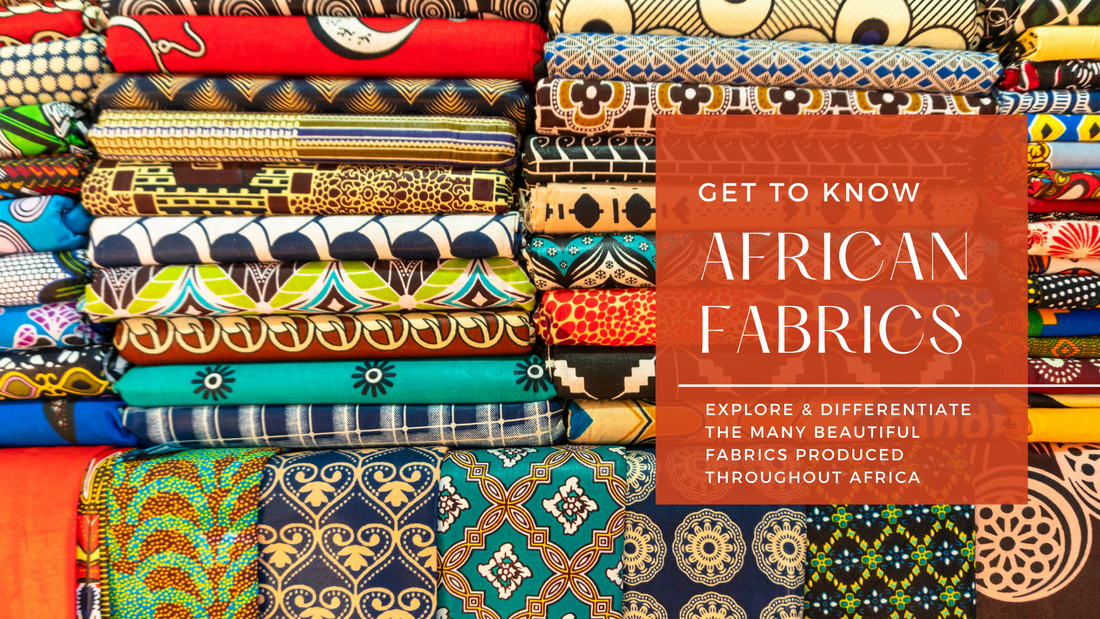
Get to Know African Fabrics
Greetings, fabric enthusiasts and culture lovers! Today, we're diving into the vibrant world of African textiles. These aren't just pieces of cloth; they're stories woven into fabric, carrying centuries of tradition, art, and identity. Here's a look at some of the most iconic African fabrics you'll find in our collections and their origins.
1. Kente - Ghana

Let's start with the star of the show - Kente. Originating from the Ashanti Kingdom in Ghana, Kente is more than just a fabric; it's a visual representation of history, philosophy, and values. Each pattern and color has a specific meaning, with bright yellows/oranges signifying wealth and royalty, while blue represents peace and harmony. Traditionally handwoven on a horizontal strip loom, Kente cloth is made into large pieces by sewing together narrow strips. It's used for significant occasions like festivals or ceremonies, but now also inspires modern fashion, which you'll see in our vibrant kente scarves and accessories.
2. Mudcloth (Bògòlanfini) - Mali
Mudcloth, or Bògòlanfini, comes from Mali. This fabric is a testament to the ingenuity of Malian artisans. The cloth is first woven by men, and then painted by women using fermented mud, which gives it those distinctive earthy tones. Each design tells a story or represents social status, characters from folklore, or proverbs. It's not just cloth; it's a canvas. You'll find mudcloth in our line adding a rustic charm to cushions and coats.
3. Kitenge or Chitenge - East Africa
Moving over to East Africa, Kitenge (often known as Chitenge in Zambia and Malawi) is similar to what many know as Ankara in West Africa but has its unique flair. It's known for its bright, bold patterns and is usually machine-printed. Kitenge is versatile, used for everything from everyday wear to ceremonial outfits. Its vibrant patterns inspire our summer dresses and headwraps, bringing a splash of color to any wardrobe.
4. Ankara (Dutch Wax Print) - West Africa

Let's talk about Ankara, the fabric that's synonymous with African fashion but has a surprising origin linked to Dutch colonization. Despite its roots, Africans made it uniquely their own. Today, these vibrant, wax-printed fabrics are everywhere from Lagos to London. The patterns are not just beautiful but often carry meanings or reflect societal issues. When you wear Ankara, you're embracing a fusion of cultures, history, and contemporary style. Ankara fabrics can be styled in clothing, such as shirts, skirts, and dresses, along with jewelry, handbags, and even head wraps. The options, and patterns, are endless!
5. Adire - Nigeria
Adire cloth from Nigeria is where art meets fabric through resist-dyeing techniques. Artisans use either tie-dye, stitch-resist, or paint directly with cassava paste to create patterns before dyeing the fabric in indigo. Each piece is unique, and the patterns often carry symbolic meanings or reflect local proverbs. Our Adire-inspired pieces bring a touch of tradition with a modern twist in shirts and bags.
6. Shweshwe - South Africa
Originally indigo-dyed and brought to South Africa by European settlers, Shweshwe has been adopted and is now intrinsically linked with South African culture. It's named after King Moshoeshoe I, who first popularized it. Today, it's produced in various colors but maintains its characteristic intricate geometric patterns, created through a discharge printing process. Look for Shweshwe in our elegant skirts and as detailed in men's shirts.

7. Kikoy - Kenya and Tanzania
Lastly, let's not forget Kikoy, which isn't just a fabric but a cultural emblem of the East African coast. Traditionally worn as a garment, it's now used for everything from beach towels to tablecloths. Kikoys are brightly colored, often with stripes, and are woven from cotton. Their versatility and durability make them perfect for our range of beachwear and home accessories.
---
Each of these fabrics tells a story of its origin, embodies the spirit of its people, and brings a piece of African heritage into our daily lives. When you wear or use these textiles, you're not just making a fashion statement; you're celebrating a rich cultural tapestry that continues to inspire and evolve.
Thanks for joining me on this textile tour! Which of these fabrics catches your eye, or better yet, which ones are you excited to incorporate into your style? Let us know, and don't forget to check out how we've woven these beautiful fabrics into our latest collections!
